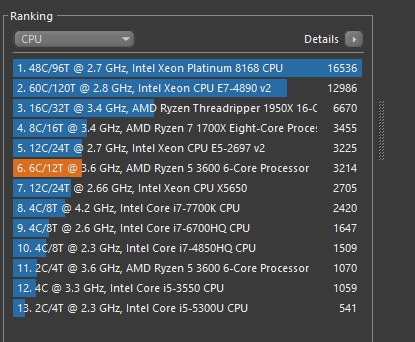Hello, im having a problem with my Ryzen 3600, i cant get it too boost to advertised clocks even in non AVX single threaded applications. For a while i ran a static 4.2GHz all core OC at 1.325 V but i abandoned it to avoid long term degradation, now im trying to get PBO+Auto OC to get something close to my manual OC but with proper auto voltage control. Im using 395W PPT, 255A TDC and 200A EDC with 10X PBO scalar and a -0.1V offset to get to stock voltages but the highest clock i get is just 4050 MHz on a single thread and 3950 on all threads (stock is about 100MHz worse) and im running between 60 C (single thread) to 75 C (prime 95 small FFTs) so temperatures aren't a problem. What settings should i adjust to get higher frequency without degrading my CPU?
Specs:
CPU: AMD Ryzen 3600
MOBO: Asus Prime B450-Plus
RAM: 2x8GB G.Skill Ripjaws V 3200 MHz CL16
GPU: XFX RX580 8 GB
CPU Cooler: Silentium PC Grandis 3 (extremely overkill for a 65W CPU)
How long did you run it with a fixed OC and VCore? You may already have degraded it if for long and doing heavy processing work, like video rendering or transcoding.
But...for some exotic PBO settings to try, especially if yours is an early silicon 3600 (one built around and just after the Zen 2 launch):
Set PPT 330, TDC 120, and EDC of 10.
Yes....EDC=10. It's a bug....or maybe loophole...in the boosting algorithm that lets the processor hold higher boosting in heavy work. But the downside is you can lose light threaded performance (single thread) if you don't also disable Advanced C States. It may not work but it's something to try and you may have to experiment a bit in the EDC 5 to 15 range. When it works, it works pretty well, as with my early silicon 3700X.
Some other pointers, but these also apply even if not exploiting EDC=10: first, make sure CPPC is enabled in BIOS and you're running a 'later' BIOS. It doesn't have to be one for Ryzen 5000, in fact it may be better if not. Make sure your chipset drivers are up-to-date, and run one of the Ryzen power plans; I use a 1Usmus plan.
A slight negative VCore off-set can help, but too much will definitely hurt boosting. Running a higher scalar is much worse than leaving VCore higher, that's because the high scalar delays the voltage pull-back to hold high boosts longer. That means voltage isn't allowed to drop away so quickly at high-temp conditions, the time when greatest degradation occurs. As long as VCore isn't spiking above 1.5V in light threaded boosting it's perfectly safe, and with a lower scalar setting it will pull it back quickly when temperature gets out of bounds for it's FIT values.
I'm not sure what your 'AutoOC is', but running an additional core boost of 200-225Mhz is often helpful. It will not do +200Mh, but it does hold about 25Mhz higher clocks after 10 min's of Prime 95 on my system.
And last: cooling, cooling, cooling. Ryzen won't toast itself even on stock cooling but better cooling means it will hit high clocks more eagerly and hold them longer. In fact, you probably won't see any performance gain at all from PBO if you don't have better than average cooling simply because it DOES raise heat output considerable. If the temperatures are not controlled the algorithm is still there to lower clocks and prevent degradation.




